All About Apples
There are many types of apples ranging from small varieties, like the Cameo, to very large varieties, like the Opalescent. Each variety has its own coloring, texture, and taste, which sets them apart from each other. Learn how easy it is to prepare and cook apples.
Whether you want to make apple butter or you just want a good apple to eat as a snack, there is sure to be one that will satisfy your needs. Select the right apple by checking our chart below. Let us show you how to prevent apples from browning when your recipe calls for fresh sliced apples where you want the apples to keep their fresh appearance. With our apple preparation guide, we can also show you how to peel, core, and slice apples for all your apple recipes whether you will be cooking apples or using them fresh.
Whether you want to make apple butter or you just want a good apple to eat as a snack, there is sure to be one that will satisfy your needs. Select the right apple by checking our chart below. Let us show you how to prevent apples from browning when your recipe calls for fresh sliced apples where you want the apples to keep their fresh appearance. With our apple preparation guide, we can also show you how to peel, core, and slice apples for all your apple recipes whether you will be cooking apples or using them fresh.
Apples | |
 An apple is a round or oval shaped fruit that is harvested from lower growing trees found in most of the temperate regions of the world. There are many types of apples. They are a fruit with a thin skin that may range in color from shades of green, yellow, and red or any combination of these. The flesh is generally off-white or cream colored and is very juicy. They are generally sweet flavored but may be slightly sour, tart, or even a bit bland depending on the variety. Some of the common varieties among the many types of apples are the Braeburn, Cortland, Fuji, Gala, Granny Smith, Golden Delicious, Red Delicious, Jonathan, Jonagold, McIntosh, and Pacific or Southern Rose. | |
| Uses: Apples can be eaten plain, made into sauce or jelly, or they can be included in a variety of salads, meat dishes, pies, and other desserts. As a dried fruit, apples can be added to a variety of baked goods or in a fresh form, they can be used to produce juice, vinegar, cider, and alcoholic beverages, such as hard cider and apple brandy. For more information on cooking with apples see Apple Cooking.To determine the best variety of apple to use for your needs, see the chart below. | |
| At Their Best: Some types of apples are available year round and some are only available at specific times of the year. The peak season for apples will vary with different varieties and locations where they are harvested. The best types of apples are those that are picked fresh from the tree. Fresh picked apples will have the best flavor and an extra crisp texture. For fresh picked apples, visit local apple farms and farmers' markets during the harvest season in your location. | |
| How to Buy: Buy apples that are brightly colored, firm, and free of bruises or damaged skin. If the flesh gives under pressure, the apple will be soft. The skin on the apple should be taut and show no signs of shriveling. Select individual apples over pre-bagged apples so that you can see what you are selecting and have an opportunity to smell the apples to make sure they have a fresh smell and are not musty. The different types of apples are graded according to their size and quality. The higher the grade, the more expensive the apple. The end use of the apple will determine the variety of apple you should buy. See the chart below to select the best variety for your needs. | |
| Storage: For best results, place apples in a perforated plastic bag, sprinkle with water and store in the coldest area of the refrigerator for 2 to 3 weeks. Apples give off a gas called ethylene that speeds up ripening, so they should be kept away from other fruits and vegetables to prevent them from ripening prematurely. Apples can be stored at room temperature for a short period of time but should be checked regularly because they will ripen more rapidly than if stored in the refrigerator. To store fresh picked apples for a long period of time, wrap them in paper and place folded side down in a single layer on a tray. Store in a cool, dark, dry place. The ideal temperature for storage is between 32°F and 40°F. Check frequently to see if any apples have begun to rot. Dried apples can be stored in a sealed plastic bag in the refrigerator for an indefinite period of time. | |
| Varieties: | |
Ambrosia Apple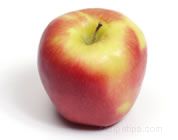 | A medium size apple with red color with some striping on a creamy yellow background. The ambrosia apple does not have a long storage life so it should be used within approximately four months of harvesting. The apple originated from British Columbia and is a good snacking apple with its crisp texture and juicy aromatic flesh. Its flesh does not oxidize and turn brown as quickly as other apples so it works great for salads. |
Arkansas Black Apple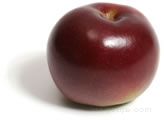 | A small to medium size deep red apple whose red color turns to a deep purplish red and at times almost looks black. It originated in Arkansas and is thought to possible be an offshoot of a Winesap apple. It has a firm, crisp, yellow flesh that has a tart aromatic flavor. The Arkansas Black apple stores well in cold storage. It will keep its freshness for 6 months when stored properly. |
Baldwin Apple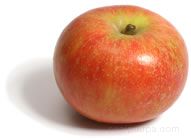 | A red-skinned apple that has streaks of yellow and is heavily speckled with russet spots. It is an all-purpose apple has a sweet-tart flavor with a slight spiciness to it. It has a crisp texture, which holds up well when cooked. Its slightly spicy flavor makes it a good choice for making cider and pies. Baldwins are not always easy to find. |
Braeburn Apple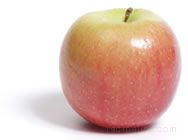 | A variety of apple that is very firm with a sweet and slightly tart flavor. It may range in color from greenish-gold to red and is popular as a snack or served in salads and desserts. |
Cameo Apple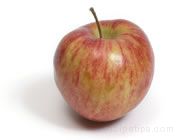 | A fairly new variety of apple that is thought to be a cross between Red and Golden Delicious apples. It has a creamy yellow colored background with red striping over it. The Cameo apple has crisp, juicy flesh with a sweet flavor and a touch of tartness. It is a good apple for snacking and to use fresh in salads. It is also a good cooking apple and makes great desserts. The Cameo stores well when refrigerated. |
Connell Red Apple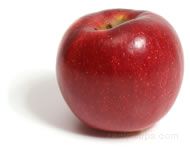 | A large size apple that is bright solid red or striped red in color. The Connell Red is a version of Fireside but is redder in color. It is slightly crisp and has a sweet flavor, which makes it a good eating apple. Connell Red apples have a firm texture that holds up well when cooked, making it a good choice for pies and sauces. |
Cortland Apple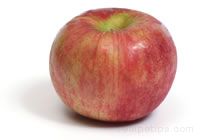 | A type of apple that has a sweet and tart flavor with creamy white flesh covered with a vibrant red skin. It is an excellent choice for use in cooked apple dishes. |
Crab Apple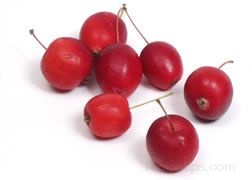 | A variety of apple that is very small in size, usually no larger than 1 to 2 inches in diameter. The outer skin may be yellow, green or red when mature and the inner flesh is a firm to hard texture. Crab apples are known for their tart flavor and they are often used to make a jelly, wine, apple butter, and other foods. |
Crimson Gold Apple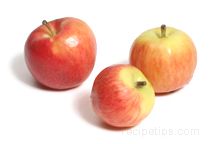 | A small variety of apple that is slightly larger than a crab apple, but much smaller than a traditional apple. The Crimson Gold Apple was developed as a cross between a Newton and Spitzenburg heirloom apple. It is a variety of apple that grows well in climates with warmer daytime temperatures with cooler evenings, to develop a higher sugar content. As it matures, this apple has a firm textured flesh that is crisp and sweet flavored. When selecting, choose apples with unblemished skins that are firm to the touch. |
Criterion Apple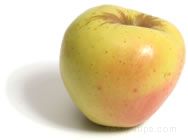 | A bright yellow skinned apple with some areas of red blushing. It has a firm, crisp texture and a mildly sweet flavor, which makes it a good eating apple. It is slow to brown when cut open so it makes a good apple in salads and it is also makes a good cooking apple. |
Elstar Apple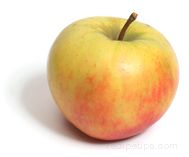 | A cross between a Golden Delicious and Cox's Orange Pippin, it is a medium to large sized apple with a firm cream colored flesh that has a sweet but slightly tart flavor. Its skin has a yellow background streaked with a blushing of red. It is a good all-purpose apple but is excellent for making applesauce. |
Empire Apple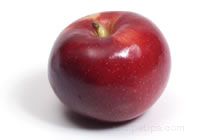 | A cross between a Delicious and a McIntosh apple, it is a medium sized apple and has a deep red coloring. The Empire has a crisp, juicy flesh that has a mildly tart but sweet flavor, making it a good snacking apple. It is also excellent for baking and salads. |
Fireside Apple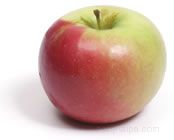 | A variety of apple, also referred to as a Connell Red, that is bright red and typically large in size. The smooth-textured, bright red outer skin covers a firm white flesh that is dense and fine textured, which provides a mildly sweet flavor. This apple stores well for longer periods of time in refrigerated areas. It is a good apple to eat out of hand or to use for cooking. Also, it dehydrates well as a dried fruit. |
Fuji Apple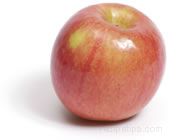 | Ranging in color from a light yellow-green with a bit of red to all red, the Fuji apple has a sweet and spicy flavor. The natural sweetness of the apple makes it a good candidate for applesauce because little sugar is required. |
Gala Apple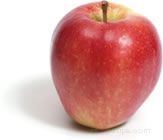 | A variety of apple that is small in size and has a skin that is yellowish-orange in color with red stripes. The flavor is sweet and not too tart, so it is a favorite as a snack. |
Ginger Gold Apple | A variety of apple that has pale green outer skin and a cream colored crisp textured flesh. It has a slightly tart flavor that is excellent for baking, cooking or for eating as a snack. It is a variety that turns brown slowly, so it is a good choice for use in fresh cut servings. |
Golden Delicious Apple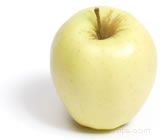 | A variety of apple that has a pale gold and freckled skin, a firm, crisp texture, and a sweet, mellow taste. The flesh resists browning and they are excellent eaten plain or used for cooking, although they lose some of their flavor when cooked. |
Golden Russet Apple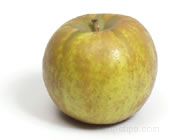 | A medium sized apple that has a distinctive greenish yellow to golden brown skin color. The flesh is firm and cream colored providing a sweet juicy flavor. This apple is a good selection for drying, for baking, and for making cider. It can be kept for months in refrigerated storage. |
Golden Supreme Apple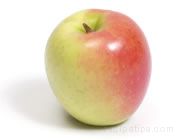 | A medium sized apple that is greenish yellow to golden brown in color with a firm cream-colored flesh that provides a sweet juicy flavor. This apple is a good selection for drying, for baking, and for making cider. It can be kept for months in refrigerated storage. |
Granny Smith Apple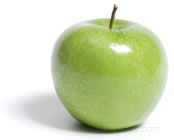 | A tart, crisp, juicy apple with freckled green skin that is as suitable for eating as it is for cooking. Granny Smith apples are imported from New Zealand and Australia and they are also grown in the United States, mainly in California and Arizona. |
Gravenstein Apple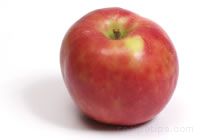 | A type of apple that typically has a green skin streaked with red, however, it can also be mostly red in color. This apple has a texture that is crisp and juicy with a flavor that is very tart. It is considered to be an all-purpose apple because of its versatility as an ingredient for pies and applesauce as well as its flavor for eating out of hand. |
| Green Pippin | A large sized apple with a round shape. Its green skin turns a greenish yellow when it is fully mature. Its white flesh is s tender and juicy. The Green Pippin ripens in September and stores well. |
| For more apples see: Types of Apples H - P | Types of Apples Q to Z | |
Choosing the Best Apple
The chart below can be used as a quick reference when deciding which apple will be best for your particular needs.| Variety of Apple | Fresh | Salad | Bake | Cook | Pie | Dried | Other |
| Ambrosia | X | X | |||||
| Baldwin | X | X | Cider | ||||
| Braeburn | X | X | X | X | X | Sauce | |
| Cameo | X | X | X | X | |||
| Connell Red | X | X | X | Sauce | |||
| Cortland | X | X | X | X | X | Sauce | |
| Crab Apples | Jelly & WineButter | ||||||
| Crimson Gold | X | ||||||
| Criterion | X | X | X | X | Sauce | ||
| Elstar | X | X | X | X | Sauce | ||
| Empire | X | X | X | X | X | X | |
| Fireside | X | X | X | X | X | X | |
| Fuji | X | X | X | X | Sauce | ||
| Gala | X | X | X | X | X | ||
| Ginger Gold | X | X | X | Sauce | |||
| Golden Delicious | X | X | X | X | X | Sauce | |
| Golden Russet | X | X | X | Cider | |||
| Golden Supreme | X | X | Cider | ||||
| Granny Smith | X | X | X | X | X | Sauce | |
| Gravenstein | X | X | X | X | Sauce | ||
| Green Pippin | X | X | Sauce | ||||
| Haralson | X | X | X | X | X | X | Sauce |
| Honeycrisp | X | X | X | X | X | X | Sauce |
| Honeygold | X | X | X | X | Sauce | ||
| Idared | X | X | X | X | X | Sauce | |
| Jonagold | X | X | X | X | X | Sauce | |
| Jonamac | X | X | X | ||||
| Jonathan | X | X | X | X | X | X | Sauce |
| Keepsake | X | X | X | ||||
| Lady | X | Sauce | |||||
| Liberty | X | X | X | X | Dessert | ||
| Macoun | X | X | X | Sauce | |||
| McIntosh | X | X | X | X* | Sauce | ||
| Melrose | X | X | X | X | |||
| Mutsu | X | X | X | X | Sauce | ||
| Newton Pippin | X | X | X | X | Sauce | ||
| Northern Spy | X | X | Sauce | ||||
| Northwest Greening | X | X | X | Sauce | |||
| Opalescent | X | X | |||||
| Pacific Queen | X | X | |||||
| Pacific Rose | X | X | |||||
| Paula Red | X | X | X | X | X | Sauce** | |
| Piñata! | X | X | X | X | X | Sauce | |
| Pink Lady | X | X | X | X | Sauce | ||
| Pink Pearl | X | X | X | Sauce | |||
| Pink Sparkle | X | X | |||||
| Prairie Spy | X | X | X | X | Sauce | ||
| Red Delicious | X | X | |||||
| Redfree | X | X | X | ||||
| Regent | X | X | X | X | X | Sauce | |
| Rhode Island Greening | X | X | X | X | Sauce | ||
| Rome | X | X | X | Sauce | |||
| Sierra Beauty | X | X | |||||
| Sonya | X | X | X | X | X | Sauce | |
| Southern Rose | X | X | |||||
| Spartan | X | X | X | X | X | Sauce | |
| Splendor | X | Dessert | |||||
| Spy Gold | X | X | X | ||||
| State Fair | X | X | X | X | Sauce | ||
| Stayman | X | X | X | X | X | ||
| Sunrise | X | X | X | ||||
| Sweet 16 | X | X | Sauce | ||||
| Wealthy | X | X | X | X | Sauce | ||
| Winesap | X | X | X | X | Sauce | ||
| Wolf River | X | X | X | X | Sauce | ||
| York Imperial | X | X | X | Sauce | |||
| Zestar | X | X | X | Sauce |
*May need a thickener when used in pies because of the juiciness of the apple.
**Very little sugar needs to be used when making applesauce with Paula Red Apples.
**Very little sugar needs to be used when making applesauce with Paula Red Apples.
Apple Equivalents
Apples come in many sizes and shapes, which makes it difficult at times to know what quantity to buy when a specific amount or size is called for. The information below is provided to assist in figuring out how much or how many to buy.| Approximate Apple Sizes (Size will vary between varieties) | |||
| Size | Diameter | Approximate Weight | Apples per Pound |
| Small | 2 1/4" | 4 oz. | 4 |
| Medium | 2 3/4" | 5 oz. to 7 oz. | 3 |
| Large | 3 3/4" | 8 oz. or more | 2 |
| Apple Equivalents Quantities are approximate amounts. Quantities may change slightly due to varying apple sizes. | ||||
| Quantity of Apples | Sliced | Diced | Grated | Sauce |
| 1 Small | 5/8 to 3/4 C. | 3/4 C. | 1/2 C. | 1/3 C. |
| 1 lb. - 4 Small | 2 3/4 C. | 3 C. | 2 C. | 1 1/3 C. |
| 1 Medium | 7/8 to 1 C. | 1 C. | 3/4 C. | 1/2 C. |
| 1 lb. - 3 Medium | 2 3/4 C. | 3 C. | 2 1/4 C. | 1 1/2 C. |
| 1 Large | 1 3/8 to 1 1/2 C. | 1 1/2 C. | 1 1/2 C. | 3/4 C. |
| 1 lb. - 2 Large | 2 3/4 C. | 3 C. | 3 C. | 1 1/2 C. |
| Miscellaneous Apple Equivalents | ||||
| 2 to 1 1/2 lbs. | One 9" Pie | |||
| 1 Peck | 10 1/2 to 12 lbs. | |||
| 1 Bushel | 42 lbs. | 20 - 24 quarts - Applesauce 18 - 20 quarts - Canned or Frozen Slices | ||
| 1 C. Dried Apples | Approximately 1 1/4 C. Cooked Apples | |||
Tips
- Apples give off a natural gas called ethylene, which speeds the ripening process for other fruits. To speed the ripening of other fruits, place an apple, with the unripe fruit, in a paper bag. Seal and make a few slits in the bag. Allow the bag to stand at room temperature for 2 to 3 days.
- Cooked apples will hold their shape better if the sugar called for in the recipe is added at the start of the cooking process. See Apple Cooking for more information on cooking with apples.
- Use a greased muffin tin to place apples in for baking. The tins will provide support for the baked apple.
- Old apples that have begun to deteriorate can be revived by peeling, cutting into chunks, and then soaking in cold apple cider or juice for approximately 30 minutes. Place in refrigerator while soaking.
- To keep apples longer, store them so that they are not touching each other.
No comments:
Post a Comment